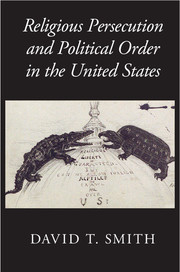Book contents
- Frontmatter
- Dedication
- Contents
- Acknowledgments
- 1 Introduction
- 2 Religious freedom and persecution in America: A theoretical overview
- 3 Joseph Smith and the rise of Mormonism: The political threat of religious charisma
- 4 The federal response to Mormonism
- 5 Jehovah's Witnesses and the flag salute, 1870–1940
- 6 Mass violence against Jehovah's Witnesses, 1940–1942
- 7 The Catholic experience in America
- 8 The Jewish experience in America
- 9 The Islamic experience in America
- 10 Conclusion
- Sources and bibliography
- Index
3 - Joseph Smith and the rise of Mormonism: The political threat of religious charisma
Published online by Cambridge University Press: 05 November 2015
- Frontmatter
- Dedication
- Contents
- Acknowledgments
- 1 Introduction
- 2 Religious freedom and persecution in America: A theoretical overview
- 3 Joseph Smith and the rise of Mormonism: The political threat of religious charisma
- 4 The federal response to Mormonism
- 5 Jehovah's Witnesses and the flag salute, 1870–1940
- 6 Mass violence against Jehovah's Witnesses, 1940–1942
- 7 The Catholic experience in America
- 8 The Jewish experience in America
- 9 The Islamic experience in America
- 10 Conclusion
- Sources and bibliography
- Index
Summary
INTRODUCTION
The Church of Jesus Christ of Latter-day Saints, which Leo Tolstoy called “the American religion,” is also the most violently persecuted religion in American history. Between the appearance of Joseph Smith's Book of Mormon in 1830 and Smith's murder in 1844, the Mormons were chased out of New York, Ohio, and Missouri by neighbors enraged at their aggressive proselytism and the extraordinary claims of Joseph Smith. The Mormons’ flight from Missouri in 1838 was prompted by a series of bloody skirmishes with well-organized opponents; Governor Lilburn Boggs responded with a quasi-genocidal executive order declaring that the Mormons had “made war upon the people of this state” and “must be exterminated or driven from the state if necessary for the public peace.”
A few years after the Mormons had fled to Illinois and established a thriving city, an anti-Mormon mob lynched Smith with the assistance of a local militia. Facing the prospect of more violence and coercion, most of the remaining Mormons undertook a long, hazardous journey to Utah under the leadership of Brigham Young in 1847, believing they would be beyond the reach of their enemies in the United States. The federal government initially encouraged the move, seeing the Mormon exodus as an opportunity to establish an American presence in the western territories newly captured from Mexico. In return for Mormon allegiance to the United States, the Fillmore Administration appointed Brigham Young as governor of Utah Territory. Relations deteriorated as the Mormon leadership became increasingly assertive over the territory, making life intolerable for non-Mormon federal officials and leading to the Buchanan Administration's brief invasion of Utah in 1857.
The abortive invasion was followed by a series of increasingly aggressive congressional actions designed to force the Mormons to conform to American anti-bigamy laws. These culminated in the Edmunds Act of 1882 and the Edmunds-Tucker Act of 1887, which forbade Mormons from voting, holding elected office, or serving on juries, and authorized the federal government to confiscate Church property, including temples. These last measures induced the Church leadership to abandon polygamy in 1890, though it continued in secret for a while; Congress held up the seating of Senator Reed Smoot for seven years over the issue of whether the Mormon leadership was still allowing plural marriages to take place at the turn of the century.
- Type
- Chapter
- Information
- Publisher: Cambridge University PressPrint publication year: 2015



